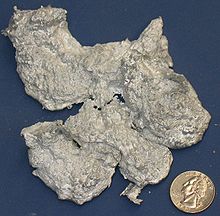അലൂമിനിയം ഓക്സൈഡ്
അലൂമിനിയത്തിന്റെയും ഓക്സിജന്റെയും ഒരു രാസസംയുക്തമാണ് അലൂമിനിയം ഓക്സൈഡ് (Aluminium oxide - ബ്രിട്ടീഷ് ഇംഗ്ലീഷിൽ) അല്ലെങ്കിൽ അലൂമിനം ഓക്സൈഡ് - (Aluminum oxide - അമേരിക്കൻ ഇംഗ്ലീഷിൽ). രാസസൂത്രവാക്യം Al2O3. പലവിധ അലൂമിനിയം ഓക്സൈഡുകളിൽ ഏറ്റവും സാധാരണ കാണപ്പെടുന്ന സംയുക്തമാണ് ഇത്. പ്രത്യേകിച്ചും അലൂമിനിയം (III) ഓക്സൈഡ് എന്നറിയപ്പെടുന്ന ഇതിനെ സാധാരണയ്ക്ക് അലൂമിന എന്നാണ് വിളിക്കുന്നത്. അലോക്സൈഡ്, അലോക്സൈറ്റ്, അലുണ്ഡം എന്നെല്ലാം പേരുകളുണ്ട്. സ്വാഭാവികമായി ക്രിസ്റ്റൽ പോളിമോർഫിക് ഫേസായ α-Al2O3 ആയി ധാതു കൊറണ്ടമായും രൂപവ്യത്യാസങ്ങളോടെ മാണിക്യമായും ഇന്ദ്രനീലമായും ഇതുകാണുന്നു. Al2O3 അലൂമിനിയം നിർമ്മാണത്തിൽ പ്രധാനപ്പെട്ട ധാതുവാണ്. കടുപ്പം കാരണം ഉരകല്ലായും ഉയർന്ന ഉരുകൽ നില കാരണം ഫർണസുകളിലെല്ലാം ഇത് ഉപയോഗിക്കുന്നു.[7]

| |

| |
| Identifiers | |
|---|---|
3D model (JSmol)
|
|
| ChEMBL | |
| ChemSpider | |
| DrugBank | |
| ECHA InfoCard | 100.014.265 |
| EC Number |
|
PubChem CID
|
|
| RTECS number |
|
| UNII | |
CompTox Dashboard (EPA)
|
|
| InChI | |
| SMILES | |
| Properties | |
| തന്മാത്രാ വാക്യം | |
| Molar mass | 0 g mol−1 |
| Appearance | white solid |
| Odor | odorless |
| സാന്ദ്രത | 3.987g/cm3 |
| ദ്രവണാങ്കം | |
| ക്വഥനാങ്കം | |
| insoluble | |
| Solubility | insoluble in diethyl ether practically insoluble in ethanol |
| log P | 0.31860[1] |
| −37.0×10−6 cm3/mol | |
| Thermal conductivity | 30 W·m−1·K−1[2] |
| Refractive index (nD) | nω=1.768–1.772 nε=1.760–1.763 Birefringence 0.008 |
| Structure | |
| Trigonal, hR30, space group = R3c, No. 167 | |
a = 478.5 pm, c = 1299.1 pm
| |
| octahedral | |
| Thermochemistry | |
| Std enthalpy of formation ΔfH |
−1675.7 kJ/mol[5] |
| Standard molar entropy S |
50.92 J·mol−1·K−1[5] |
| Hazards | |
| GHS pictograms | 
|
| Flash point | {{{value}}} |
| NIOSH (US health exposure limits): | |
PEL (Permissible)
|
OSHA 15 mg/m3 (Total Dust) OSHA 5 mg/m3 (Respirable Fraction) ACGIH/TLV 10 mg/m3 |
REL (Recommended)
|
none[6] |
IDLH (Immediate danger)
|
N.D.[6] |
| Related compounds | |
| Other anions | aluminium hydroxide aluminium sulfide aluminium selenide |
| Other cations | boron trioxide gallium oxide indium oxide thallium oxide |
Except where otherwise noted, data are given for materials in their standard state (at 25 °C [77 °F], 100 kPa).
| |
സ്വാഭാവികമായ ലഭ്യത
തിരുത്തുകഗുണങ്ങൾ
തിരുത്തുകപ്രതിപ്രവർത്തനം
തിരുത്തുകAluminium oxide is an amphoteric substance, meaning it can react with both acids and bases, such as hydrofluoric acid and sodium hydroxide, acting as an acid with a base and a base with an acid, neutralising the other and producing a salt.
- Al2O3 + 6 HF → 2 AlF3 + 3 H2O
- Al2O3 + 2 NaOH + 3 H2O → 2 NaAl(OH)4 (sodium aluminate)
രൂപം
തിരുത്തുകഉൽപ്പാദനം
തിരുത്തുകഉപയോഗങ്ങൾ
തിരുത്തുകഫില്ലർ
തിരുത്തുകഗ്ലാസ്സ്
തിരുത്തുകഉൽപ്രേരകമായി
തിരുത്തുകശുദ്ധീകരണത്തിന്
തിരുത്തുകAbrasive
തിരുത്തുകപെയിന്റ്
തിരുത്തുകComposite fiber
തിരുത്തുകAbrasion protection
തിരുത്തുകമറ്റുള്ളവ
തിരുത്തുകഇവയും കാണുക
തിരുത്തുക- Aluminium oxide nanoparticle
- Charged Aerosol Release Experiment (CARE)
- List of alumina refineries
- Micro-Pulling-Down
- Transparent alumina
- Bauxite tailings
അവലംബം
തിരുത്തുക- ↑ "Aluminum oxide_msds".
- ↑ Material Properties Data: Alumina (Aluminum Oxide) Archived 2010-04-01 at the Wayback Machine.. Makeitfrom.com. Retrieved on 2013-04-17.
- ↑ Patnaik, P. (2002). Handbook of Inorganic Chemicals. McGraw-Hill. ISBN 978-0-07-049439-8.
- ↑ Raymond C. Rowe; Paul J. Sheskey; Marian E. Quinn (2009). "Adipic acid". Handbook of Pharmaceutical Excipients. Pharmaceutical Press. pp. 11–12. ISBN 978-0-85369-792-3.
- ↑ 5.0 5.1 Zumdahl, Steven S. (2009). Chemical Principles 6th Ed. Houghton Mifflin Company. ISBN 978-0-618-94690-7.
- ↑ 6.0 6.1 "NIOSH Pocket Guide to Chemical Hazards #0021". National Institute for Occupational Safety and Health (NIOSH).
- ↑ "Alumina (Aluminium Oxide) – The Different Types of Commercially Available Grades". The A to Z of Materials. Archived from the original on 10 October 2007. Retrieved 2007-10-27.